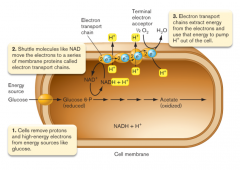![]()
![]()
![]()
Use LEFT and RIGHT arrow keys to navigate between flashcards;
Use UP and DOWN arrow keys to flip the card;
H to show hint;
A reads text to speech;
31 Cards in this Set
- Front
- Back
|
pH and Living Cells |
- tolerate a greater pH range than any other chemical substance - majority of enzymes operate best between pH 5 to 8.5 - cells evolved to live under different pH conditions by using homeostasis strategies that keep internal pH between 5 and 8 |
|
|
Neutralophiles |
- grow between pH 5 and 8 - includes most human pathogens - some like E.coli maintain an internal pH slightly above neutral even if enviro pH fluctuates |
|
|
Acidophiles |
- microbes that live in acidic environments - often chemoautotrophs (reduce metal and generate strong acids - maintain internal pH of 5.5 to 6.5 -altered membrane lipids decrease proton permeability (allows growth in low pH |
|
|
Alkaliphiles |
- commonly found in saline soda lakes - grows between pH 9-11 |
|
|
Aerobic Respiration |

|
|
|
Aerobe |
- Lives in O2 - requires O2 as terminal electron acceptor during respiration |
|
|
Anaerobe |

- dies when O2 is present at high enough concentrations - does not use O2 as a terminal electron donor - Everything started as anerobes |
|
|
Anaerobic Respiration |
- using ETC but with alternative terminal electron acceptor, like nitrate (NO3-) - Or Fermentation |
|
|
Fermentation |
- ATP produced through substrate level phosphorylation in a process that does not require O2 or ETC |
|
|
Facultative Anaerobes |
- possess enzymes that destroy toxic oxygen products, but can use aerobic or anaerobic metabolism |
|
|
Aerotolerant Anaerobes |
- only use fermentation to provide energy but have protective enzymes and can live in O2 |
|
|
Three O2 Removing Techniques |
- reducing agents - anaerobe jar - anaerobe glove box |
|
|
reducing agents |
- eliminate dissolved O2 - can be added to liquid media |
|
|
anaerobe jar |
- Plates streaked with the organism are placed into a sealed jar with a packet that releases H2 and CO2 gases |
|
|
anaerobe glove box |
- atmosphere inside box is removed by vacuum and replaced by N2 and CO2 gas |
|
|
When Nutrients Decline |
- growth rate slows - metabolic slowdown - nutrient transporters produced - Glycogen produced as emergency store - spores produces (some gram-positive species) - Growth morphology changes |
|
|
Eutriphication |
- sudden infusion of large quantities of a formerly limiting nutrient - can lead to bloom of microbes - organism grows unrestricted, consuming nutrients others rely on - Human impact can cause this |
|
|
Sterilization |
- |
|
|
Disinfection |
- |
|
|
Antisepsis |
- |
|
|
Sanitation |
- |
|
|
Antimicrobials |
- Classified by the species they kill |
|
|
Steam Autoclaces |
- sterilize equipment and solutions - moist heat more effective killer than dry heat - combination of high heat and high pressure - sterilizes |
|
|
Pasteurization |
- kills pathanogenic bacteria in food - High temp short time, flash pasturization - Low temperature long time |
|
|
Filtering a Solution |
- can remove microbes bigger than 0.2 microns
|
|
|
Laminar Flow Biological Safety Cabinets |
- used for working with things that need to keep sterile |
|
|
Irradiation |
- bombardment of foods with high E radiation to sterilize - gamma rays, electron beams, and x-rays |
|
|
Chemical Agents |
- broad impact to kill many microbes - non-corrosive - stable during storage - neutral or pleasant odor - low surface tension to penetrate cracks - best when physical disinfection is impracticle |
|
|
Common Disinfectants |
- Iodine - Chlorine - detergents (disrupts bacterial membranes, and physical removal of bacteria) |
|
|
Anti-biotic |
- either kills or inhibits the growth of a microorganism - many are isolated from bacteria - either inhibits cell wall synthesis (blocks peptidoglycan synthesis) - or inhibits protein synthesis (disrupts bacterial ribosomes) |
|
|
Penicillin |
- disrupts peptidoglycan cell wall - actively growing cells will lyse without support of cell wall |

